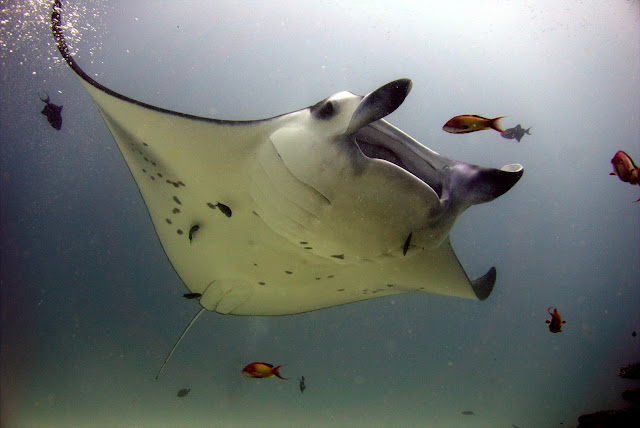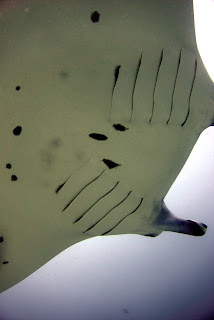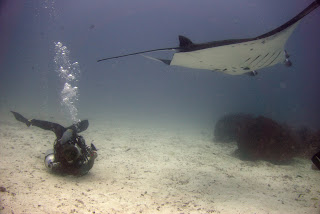| Josie had an encounter with 16 Mantas on the cleaning station! Credit: Josie Chandler |
After a slightly disappointing 61 Manta Ray sightings in 2013, and a promising increase of 106 sightings during 2014: 2015 should officially be declared the year of the Manta! So far no less than 128 Manta rays have been spotted by Gili Lankanfushi divers, and we are only part way through the season!
Our Manta season really kicked off in August with our first sighting at Sunlight Thila during a snorkeling trip. Four lucky guests were treated to a display of no less than twelve train-feeding Mantas after a coral spawning event!
Manta rays flock to the Eastern side of the atoll, following their plankton food, during the HulHangu South West monsoon in July, and are commonly seen visiting ‘cleaning stations’, where small fish aggregate to eat their parasites.
Since the Sunlight sighting, we have been diving the famous Lankan Corner Manta Point cleaning station every day and have not been disappointed! Historically the site was a ‘Manta Mecca’, with many Mantas aggregating to freshen up as cleaner fishes nip away their parasites, and to find a mate, with courtship displays proving a common sight. In previous years, Manta sightings at Lankan Corner have severely dropped for unknown reasons, but this year it’s exciting to see the site return to its former glory with Mantas having been spotted in the area every day for the last month, and up to 16 individuals seen at one time on the cleaning station!
 |
| This Sunlight Thila visitor allows small cleaner fish to eat his parasites Credit: Deborah Burn |
 |
| A branchial (gill) shot is usually enough for a positive ID Credit: Deborah Burn |
Gili Lankanfushi has always worked together with the Manta Trust to collect data regarding our sightings, and recently we have also partnered up with the Manta Ecology Project to help develop the Manta Matcher database. Each Manta Ray has a unique spot pattern on its belly that can be used as an identification tool. By sending our ID photographs, we are helping to discover more about these magnificent creatures in terms of health, migrations and life cycles.
 |
| Josie taking the perfect belly ID shot Credit: Deborah Burn |
We hope to see the beautiful Mantas hang around as the season continues, and if we are lucky, hopefully we will see some courtship behaviour, which could confirm for us that the site has indeed returned to how it was 20 years previously. We also actively encourage our guests to get involved with Manta Ray conservation and upload your sighting information and photographs to the Manta Trust by clicking HERE, and Manta Matcher, by clicking HERE.